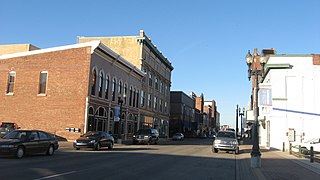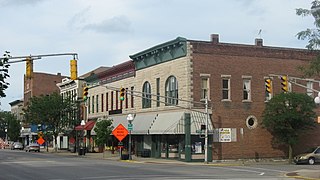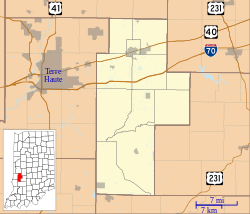
The Greensburg Downtown Historic District is a national historic district located at Greensburg, Decatur County, Indiana. It encompasses 67 contributing buildings and 3 contributing objects in the central business district of Greensburg. The district developed between about 1854 and 1945, and includes notable examples of Italianate, Queen Anne, and Classical Revival style architecture. Located in the district are the separately listed Decatur County Courthouse and Knights of Pythias Building and Theatre. Other notable buildings include the Palmer Building, YMCA (1915), City Hall (1874), U.S Post Office, George E. Erdmann Building (1908),.

Geneva Downtown Commercial Historic District is a national historic district located at Geneva, Adams County, Indiana, USA. It encompasses 22 contributing buildings in the central business district of Geneva. were built between about 1882 and 1930, and include notable examples of Italianate and Romanesque Revival style commercial architecture. Notable buildings include the M.E. Hutton Carriage Shop (1895-1896), Briggs Hardware (1882), Shamrock Block, and the Independent Order of Odd Fellows building (1906).

Downtown Aurora Historic District is a national historic district located at Aurora, Dearborn County, Indiana. The district encompasses 272 contributing buildings, 1 contributing site, and 3 contributing structures in the central business district of Aurora. The district developed between about 1830 and 1944, and includes notable examples of Italianate, Federal, and Greek Revival style architecture. Located in the district are the separately listed Aurora City Hall, Aurora Methodist Episcopal Church, Aurora Public Library, First Evangelical United Church of Christ, First Presbyterian Church, George Street Bridge, Hillforest, Lewis Hurlbert, Sr. House, Leive, Parks and Stapp Opera House, and George Sutton Medical Office. Other notable buildings include the T. and J.W. Gaff Distillery (1843), First National Bank (1924), I.O.O.F. Hall (1887), B&O Railroad Station (1911-1917), John Neff Building, Chamber Stevens & Co. Dry Goods Store, U.S. Post Office (1935), Star Milling Co. (1891), and St. John's Evangelical Lutheran Church (1874).

Downtown Lawrenceburg Historic District is a national historic district located at Lawrenceburg, Dearborn County, Indiana. The district encompasses 257 contributing buildings and 2 contributing objects in the central business district and surrounding residential sections of Lawrenceburg. The district developed between about 1815 and 1900, and includes notable examples of Late Victorian, Federal, and Greek Revival style architecture. Located in the district are the separately listed Dearborn County Courthouse and Hamline Chapel United Methodist Church. Other notable buildings include the Trade and Industrial Building (1881), Lawrenceburg Theater (1875), Jesse Hunt Hotel (1818), the birthplaces of James B. Eads and Louis Skidmore.

Downtown Auburn Historic District is a national historic district located at Auburn, DeKalb County, Indiana. The district encompasses 52 contributing buildings in the central business district of Auburn. The district developed between about 1870 and 1935, and includes notable examples of Victorian, Classical Revival, Romanesque Revival, and Colonial Revival style architecture. Notable buildings include the DeKalb County Courthouse (1911-1914), Henry Opera House (1917), DeKalb County Jail (1918), Commercial Club (1917), Auburn City Hall (1913), South Interurban Station, Dilgard Building, Y.M.C.A. Building (193-1914), Auburn Hotel (1922), U.S. Post Office (1934), and Masonic Temple.

Goldsmith C. Gilbert Historic District is a national historic district located at Muncie, Delaware County, Indiana. It encompasses 75 contributing buildings and is located in the oldest residential section of Muncie. The district includes notable examples of Late Victorian, Colonial Revival, and Bungalow / American Craftsman style architecture. Located in the district is the separately listed J.C. Johnson House. Other notable buildings include the A.L. Johnson House, Meeks Mortuary Building, Joseph Hummel House, and Miller Livery (1916).

Walnut Street Historic District is a national historic district located at Muncie, Delaware County, Indiana. It encompasses 66 contributing buildings and 1 contributing object, and is located in the central business district of Muncie. The district includes notable examples of Italianate, Late Victorian, Colonial Revival, and Beaux-Arts style architecture. Located in the district are the separately listed Moore-Youse-Maxon House, Roberts Hotel, and Goddard Warehouse. Other notable buildings include the Patterson Bock, McNaughton Block (1901-1903), Mitchell Block (1909), American National Bank Building (1924), Marsh Block (1888), and the Old Post Office designed by the Office of the Supervising Architect under James Knox Taylor.

Elkhart Downtown Commercial Historic District is a national historic district located at Elkhart, Elkhart County, Indiana. The district encompasses 59 contributing buildings in the central business district of Elkhart. It was developed between about 1868 and 1930, and includes notable examples of Italianate, Queen Anne, and Classical Revival style architecture. Located in the district are the separately listed Green Block, Lerner Theatre, and Young Women's Christian Association. Other notable buildings include the Cornish Block, Franklin Street Station (1895), Menges Building (1908), former Post Office (1905), Midwest Museum of Modern Art (1922), Elkhart Water Company, Masonic Temple, Rowe Block (1900), and Dreves Building.

Downtown Nappanee Historic District is a national historic district located at Nappanee, Elkhart County, Indiana. The district encompasses 26 contributing buildings in the central business district of Nappanee. It was developed between about 1874 and 1939, and includes notable examples of Italianate and Classical Revival style architecture. Notable buildings include the Bechtel Building (1888), U.S. Post Office, Dietrich Block, Kaufman's Department Store (1902), First National Bank, Yoder's Garage, B&O Depot, Hartman Brothers Building, and Farmers and Traders Bank (1915).

Attica Downtown Historic District is a national historic district located at Attica, Fountain County, Indiana. The district encompasses 50 contributing buildings in the central business district of Attica. It developed between about 1840 and 1942, and includes notable examples of Art Deco, Gothic Revival, and Classical Revival style architecture. Notable buildings include the U.S. Post Office (1935) designed by the Office of the Supervising Architect under Louis A. Simon, McDonald House (1840), Revere Hotel (1853), and I.O.O.F Building.

Marion Downtown Commercial Historic District is a national historic district located at Marion, Grant County, Indiana. It encompasses 52 contributing buildings, 2 contributing structures, and 1 contributing object in the central business district of Marion. It developed between about 1870 and 1942, and includes notable examples of Italianate, Romanesque, and Classical Revival style architecture. Located in the district is the separately listed Grant County Jail and Sheriff's Residence. Other notable buildings are the Grant County Courthouse (1881–1883), Marion Bank Building, Iroquois Building, Dan-Mar Apartments, United Telephone Block, Cecelian Apartments, Marion Post Office, and William Smith Building / Mecca Club.

Sheridan Downtown Commercial Historic District is a national historic district located at Sheridan, Hamilton County, Indiana. It encompasses 38 contributing buildings and 1 contributing structure in the central business district of Sheridan. It developed between about 1880 and 1939, and includes notable examples of Italianate and Romanesque Revival style architecture. Notable buildings include the H.J. Thistlethwaite Building (1886), Carnegie library, First Christian Church (1910-1911), Higbee Buggy Company, American State Bank (1914), Stanley Brothers Building, Slliot's Drugstore, Indiana Telephone Company building, and U.S. Post Office (1939-1940).

North Vernon Downtown Historic District is a national historic district located at North Vernon, Jennings County, Indiana. It encompasses 80 contributing buildings and 1 contributing structure in the central business district of North Vernon. The district developed between about 1852 and 1955, and includes notable examples of Federal, Italianate, Classical Revival, and Bungalow / American Craftsman style architecture. Notable contributing buildings include the First Christian Church, M.T. Lindley Building (1891), N.C. Bank, Masonic Lodge (1899), Red Man Lodge #99, Jennings County Carnegie Library (1920), Bantz Building, Ades Building (1913), Perry-Verbiage Building, Couchman Building, and Gottwalles Grocery (1893).

Ellettsville Downtown Historic District is a national historic district located at Ellettsville, Monroe County, Indiana. The district encompasses 50 contributing buildings in the central business district and surrounding residential sections of Ellettsville. It developed between about 1840 and 1953, and includes notable examples of Queen Anne, Early Commercial, Gothic Revival, and Bungalow/American Craftsman style architecture. Notable buildings include the Robert Stimson House, May Presley House, Bradford House, George W. Fletcher House, Wickens House (1909), Capt. Gilbert Perry House, I.O.O.F. Building, Town Hall (1927), Masonic Building (1895), Knights of Pythias Building, First United Methodist Church (1900), and First Baptist Church (1909).

Kendallville Downtown Historic District is a national historic district located at Kendallville, Noble County, Indiana. The district encompasses 45 contributing buildings in the central business district of Kendallville. It developed between about 1863 and 1940, and includes notable examples of Italianate, Queen Anne, Romanesque Revival, Classical Revival, and Bungalow / American Craftsman style architecture. Located in the district is the separately listed Iddings-Gilbert-Leader-Anderson Block. Other notable buildings include the City Hall (1914), Diggins Building (1892), Masonic Hall Building, and Bernhalter Building.

Mount Vernon Downtown Historic District is a national historic district located at Mount Vernon, Posey County, Indiana. The district encompasses 39 contributing buildings, 2 contributing sites, 1 contributing structure, and 2 contributing objects in the central business district of Mount Vernon. It developed between about 1850 and 1953, and includes notable examples of Italianate, Queen Anne, Romanesque Revival, and Classical Revival style architecture. Located in the district is the separately listed Posey County Courthouse Square. Other notable contributing resources include the McFadin Cemetery, Sherburne Park, the Armory (1922), the Alexandrian (Carnegie) Library (1905), City Hall (1893), Fogas Building (1880), Eagles Home (1917), Palace Soda Shop, Memorial Coliseum (1925), and the Opera House (1879).

Farmland Downtown Historic District is a national historic district located at Farmland, Randolph County, Indiana.

Highland Park Neighborhood Historic District is a national historic district located at Lafayette, Tippecanoe County, Indiana. The district encompasses 240 contributing buildings, 1 contributing site, and 1 contributing structure in a planned residential subdivision of Lafayette. It developed between about 1892 and 1945 and includes representative examples of Queen Anne, Tudor Revival, and Bungalow / American Craftsman style architecture. Notable contributing resources include the Blistain Axel Merritt House (1914), John Wagner Jr. House, John Ross House, and Bicycle Bridge (1924).

Ninth Street Hill Neighborhood Historic District is a national historic district located at Lafayette, Tippecanoe County, Indiana. The district encompasses 88 contributing buildings and 6 contributing structures in a predominantly residential section of Lafayette. It developed between about 1850 and 1946 and includes representative examples of Gothic Revival, Italianate, Queen Anne, Greek Revival, and Second Empire style architecture. Located in the district is the separately listed Judge Cyrus Ball House. Other notable contributing resources include the Samuel Moore House (1891), Moore-Porter-Boswell House (1895), Stanley Coulter House (1890), Edward Bohrer House (1909), Thomas Wood House, Job M. Nash House (1859), and Gordon Graham House.

Clinton Downtown Historic District is a national historic district located at Clinton, Vermillion County, Indiana. The district encompasses 46 contributing buildings, 1 contributing site, and 1 contributing object in the central business district of Clinton. It developed between about 1880 and 1935 and includes representative examples of Italianate, Romanesque Revival, and Bungalow / American Craftsman style architecture. Notable contributing resources include the C. & E. I Passenger Station, Bogart Park and Claude Matthews bust / memorial, Scott-Martin Block (1907), H.H. Wisehart Building (1915), Mark W. Lyday Building, Ford Agency Building, and C. & E. I Freight Depot (1912).

























